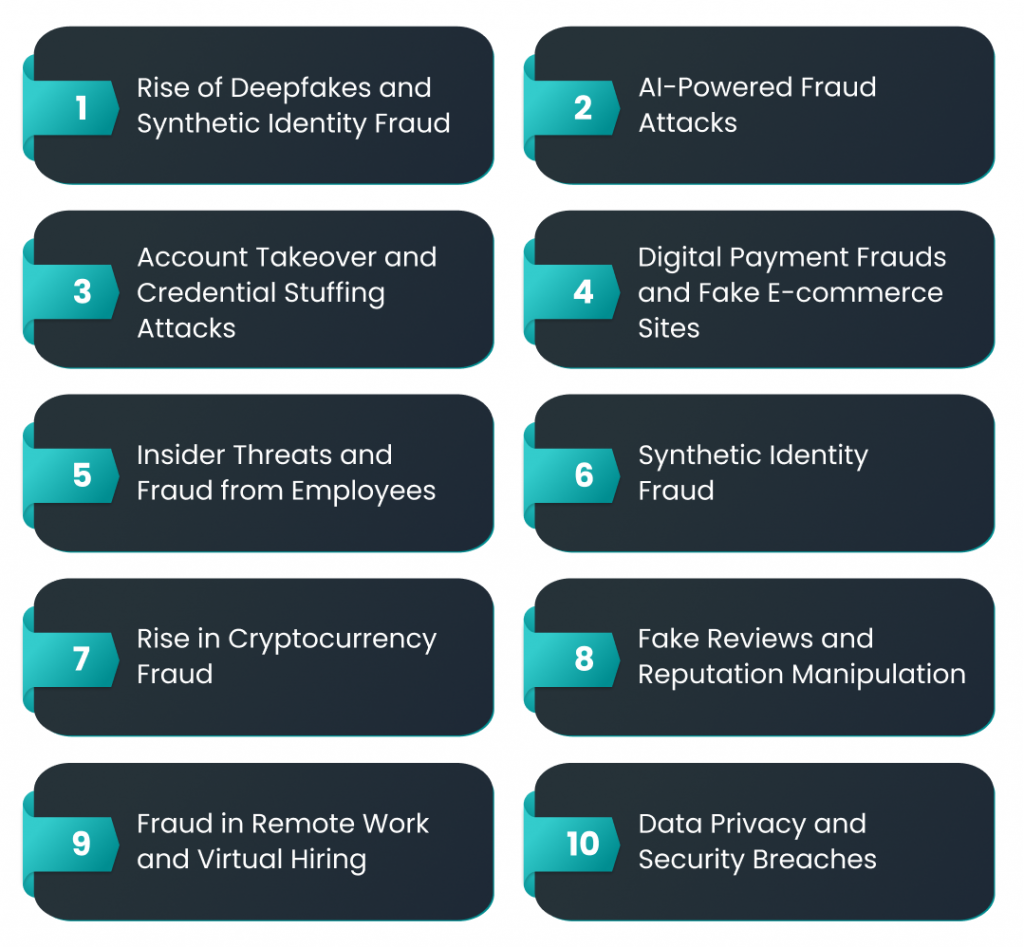Table of Contents
ToggleFraud is an ever-evolving threat to businesses across all sectors. As technology advances and fraudsters become more sophisticated, businesses must be vigilant and prepared to combat the increasing range of fraudulent activities. In 2025, the landscape of fraud will be shaped by emerging trends and evolving technologies, making it more critical than ever for organizations to stay ahead of these threats.

1. Rise of Deepfakes and Synthetic Identity Fraud
Deepfakes—AI-generated images, videos, and audio that manipulate reality—have gained significant attention in recent years, and in 2025, they will continue to be a major threat. Fraudsters will use deepfakes to impersonate executives, employees, and even customers, gaining access to sensitive information or executing fraudulent transactions. This poses a significant challenge for identity verification systems, as deepfakes can convincingly mimic a person’s voice or face.
Key Points:
- What to Watch: Fake video and audio clips used for social engineering and data theft.
- Impact: Increased risk of financial fraud, reputational damage, and security breaches.
- Prevention: Implement advanced biometrics, multi-factor authentication (MFA), and AI-driven fraud detection tools to verify identities in real-time.
2. AI-Powered Fraud Attacks
Artificial Intelligence (AI) is not only a tool for detecting fraud but also for perpetrating it. In 2025, we will see a rise in AI-powered fraud attacks, where fraudsters use machine learning algorithms to find vulnerabilities, manipulate systems, and conduct scams. These AI-driven attacks will be harder to detect and may evolve rapidly, making it necessary for businesses to adopt adaptive fraud detection mechanisms.
Key Points:
- What to Watch: AI algorithms used to hack into databases, manipulate financial transactions, and automate fraud.
- Impact: More sophisticated attacks that outpace traditional detection methods.
- Prevention: Leverage AI-driven fraud detection tools that can learn from patterns and adapt in real time to prevent attacks.
3. Account Takeover and Credential Stuffing Attacks
As the number of online services increases, so do the opportunities for fraudsters to exploit weak or reused passwords. Account takeover (ATO) and credential stuffing attacks will continue to dominate the fraud landscape in 2025, where fraudsters use stolen login credentials to gain unauthorized access to accounts and make fraudulent purchases or transactions.
Key Points:
- What to Watch: Large-scale automated attacks using stolen or leaked credentials to access accounts.
- Impact: Loss of customer trust, financial losses, and data breaches.
- Prevention: Implement robust password policies, multi-factor authentication, and continuous monitoring for unusual login activity.
4. Digital Payment Frauds and Fake E-commerce Sites
The continued growth of online shopping and digital payments will open the door for more fraudulent activities. In 2025, fraudsters will increasingly target digital payment platforms and e-commerce sites by creating fake websites, setting up fake payment gateways, or exploiting vulnerabilities in payment systems. These fraudulent activities will primarily affect consumers, but businesses will also bear the brunt of lost revenue and damage to brand reputation.
Key Points:
- What to Watch: Fake e-commerce websites, phishing attacks targeting online shoppers, and fraudulent payment gateways.
- Impact: Increased chargebacks, loss of revenue, and tarnished brand reputation.
- Prevention: Regularly audit payment gateways, employ anti-phishing tools, and ensure secure website protocols like HTTPS.
5. Insider Threats and Fraud from Employees
While much attention is given to external fraud, insider threats—fraud committed by employees or contractors—will continue to be a significant issue in 2025. Employees who have access to sensitive financial information or systems may engage in fraudulent activities, such as stealing funds, leaking sensitive data, or manipulating company records for personal gain.
Key Points:
- What to Watch: Employees or contractors who have access to financial systems and sensitive data.
- Impact: Direct financial loss, data leaks, regulatory fines, and damage to corporate integrity.
- Prevention: Implement strong internal controls, monitor employee behavior, and enforce a zero-tolerance policy for fraud.
6. Synthetic Identity Fraud
Synthetic identity fraud is on the rise, with fraudsters combining real and fake information to create entirely new, fabricated identities. These synthetic identities are often used to open fraudulent accounts, commit financial crimes, and launder money. This type of fraud can be difficult to detect because the synthetic identities are not tied to a real person, making it harder to trace the fraudulent activity back to an individual.
Key Points:
- What to Watch: Fraudsters combining real data (such as a valid Social Security number) with fake details (like a fabricated name or address).
- Impact: Increased fraudulent account openings, false credit applications, and financial crimes.
- Prevention: Use advanced identity verification and data analytics to identify discrepancies in customer information and monitor for unusual activity.
7. Rise in Cryptocurrency Fraud
Cryptocurrency adoption has increased in recent years, but so has its exploitation for fraudulent activities. In 2025, we will see a surge in cryptocurrency-related fraud, including Ponzi schemes, fake ICOs (Initial Coin Offerings), and pump-and-dump schemes. The anonymity provided by cryptocurrencies makes it an attractive medium for fraudsters to launder money and conduct scams.
Key Points:
- What to Watch: Fraudulent cryptocurrency investments, fake ICOs, and deceptive crypto exchanges.
- Impact: Financial loss for investors, damage to crypto market integrity, and regulatory scrutiny.
- Prevention: Educate customers on cryptocurrency scams, employ robust due diligence processes, and ensure transparency in crypto investments.
8. Fake Reviews and Reputation Manipulation
Online reviews and testimonials play a major role in influencing consumer decisions. However, in 2025, fraudsters will increasingly use fake reviews and reputation manipulation tactics to deceive consumers. Businesses may fall victim to fake reviews, which could damage their reputation or mislead potential customers.
Key Points:
- What to Watch: Fake positive or negative reviews designed to sway consumer decisions or harm competitors.
- Impact: Loss of trust, customer confusion, and potential legal consequences.
- Prevention: Use AI-driven tools to detect fraudulent reviews and maintain transparency in customer feedback.
9. Fraud in Remote Work and Virtual Hiring
The shift to remote work and virtual hiring will give rise to new fraud trends. Fraudsters may take advantage of the increase in online job applications by posing as legitimate employers or job seekers. Additionally, virtual hiring processes may be manipulated to conduct fraudulent background checks or scam job seekers out of personal information or money.
Key Points:
- What to Watch: Fake job offers, phishing attacks targeting job seekers, and fraudulent background checks.
- Impact: Loss of personal data, financial scams, and damaged reputations for businesses.
- Prevention: Conduct thorough background checks, use legitimate job portals, and ensure secure communication channels for virtual hiring.
10. Data Privacy and Security Breaches
As data privacy regulations continue to evolve, so will the sophistication of data breaches and privacy violations. In 2025, businesses will face increasing pressure to safeguard personal data. However, fraudsters will exploit weaknesses in data security systems to steal sensitive information, leading to identity theft and financial fraud.
Key Points:
- What to Watch: Data breaches, unsecured cloud storage, and exploitation of third-party vendors.
- Impact: Loss of customer trust, hefty fines, and reputational damage.
- Prevention: Employ robust data encryption, conduct regular security audits, and comply with data protection regulations.
As fraud continues to evolve, businesses must stay ahead of emerging fraud trends to protect themselves, their customers, and their reputation. In 2025, we will witness an increased reliance on technology by fraudsters, making it essential for organizations to adopt proactive fraud prevention strategies. From deepfakes and synthetic identity fraud to the rise of AI-powered attacks and cryptocurrency scams, the fraud landscape will continue to pose significant risks to businesses across industries.
Read also: Beyond KYC: The Evolution of Identity Verification for Businesses
By understanding these trends and implementing robust security measures, businesses can safeguard against fraud and ensure a secure and trustworthy environment for all stakeholders.





Leave a Reply